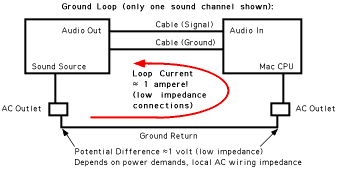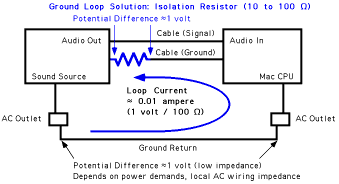![]()
[Support] [Product Info] [Downloads] [Ordering] [Home <www.channld.com/software.html>]
Avoiding ground-loop induced hum in audio connections
Input "hum" can arise from small ground potential differences between signal inputs and outputs.
The grounds between sound hardware 'boxes' are established by the AC outlets, and through signal cables. Various factors can cause small ground potential differences between the sound input (computer) and output (the sound source).
A one-volt difference, while seemingly insignificant, can cause large loop currents to flow through the ground conductor of the signal cable. Depending on the circuit configuration of the audio hardware, the audio signal impedance and the impedance of the signal cable ground, the currents may cause induced voltages in the audio circuitry. This is a source of the familiar 'hum' problem.
This situation is shown in the simplified illustration below.

[The 1 volt potential difference, 1 ohm loop impedance can be rescaled to other situations (10 millivolt potential difference, 10 milliohm audio circuitry / cable ground and interconnection impedance), providing the same result.]
To solve the problem, the goal is to reduce the magnitude of the loop current. This is done simply by inserting isolation resistor(s) in series with the audio cable ground(s). A usual value for the resistor is 10 to 100 ohms. Note that all signal ground connections between audio equipment must be isolated.

[A smaller, 10 millivolt ground return potential difference translates to an insignificant (in properly designed audio circuitry) 100 microamp loop current, with a 100 ohm isolation resistor.]
This technique is used in the optional 3.5 mm mini-plug cable supplied with Channel D's Mac the Scope: 100 ohm resistors are incorporated into the signal connectors.
Connecting a heavy-gauge wire between the chassis' of the affected units also can solve the problem, by providing a low impedance path for loop currents (which then will flow through the wire, instead of the audio connections). However, it's tricky to properly implement this method, because the impedance of the return wire must be significantly lower than the audio cable ground impedance, even at frequencies above the audio range. If not, problems with radio-frequency pickup may occur, which can introduce distortion and noise in audio circuitry.
Balanced signal connections, found in professional audio hardware and scientific instrumentation, are much less susceptible to ground loop (and other noise pickup) problems, because signals are transmitted and amplified differentially. Here, noise rejection is excellent at "hum" frequencies.
Hum also can arise from other, less subtle causes (bad signal connections). Also, if both audio units are not connected to AC power (one or both is battery powered), the ground loop condition, as described above, cannot occur.
[Support] [Product Info] [Downloads] [Ordering] [Home <www.channld.com/software.html>]